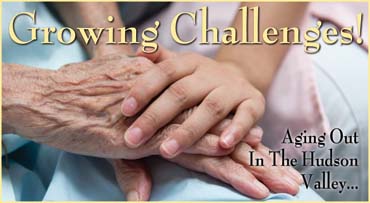Serving the Towns of Wawarsing, Crawford, Mamakating, Rochester and Shawangunk, and everything in between | |||
| |||
|
Growing Challenges!
Aging Out In The Hudson Valley...
REGIONAL – If there's a theme to our times it's that changes are coming fast and furious and it's hard to keep up.
Hudson Valley Pattern for Progress has just released a report on Aging in the Hudson Valley that points up once again the need for a regional approach to new challenges, and contains much fascinating information, some of it disturbing to contemplate. Our regional population is aging, and currently we have a bit of a mismatch between supply of a certain kinds of service and demand for another. The report's authors, March Gallagher of Pattern for Progress and Daniel Aronzon, MD, estimate there are 1,700 excess hospital beds projected through 2040. However, there is a growing shortage for long term home health care capacity. "We're going to lack it even more in the future and it's really important to match home health care capacity with need," Gallagher says. "There are better outcomes both for patients and for the financial health of the system if people can stay in their own homes." The report tables comparative costs — the national average cost of nursing home care, per day, is $219. In Ulster County, it's $358, while in Dutchess/Orange, $401. The cost for home health aide services is similarly $122, $144, and $144 respectively, while the cost of an assisted living facility runs, $115 in Dutchess/Orange. At the same time, demand for what are called skilled nursing facility beds (formerly known as nursing homes) is falling, part of a nationwide trend. Put this down to dislike of the idea of living in a nursing home combined with efforts to avoid this fate. Whether it's older people jogging, or maintaining healthier diets and lifestyles, seniors are expressing a stronger interest in staying in their homes and avoiding nursing homes. The report notes that the Baby Boomer generation will provide challenges to the system as it ages. The population over 65 in the region will rise from 13.8 percent in 2010 to 18.8 percent in 2040. But beyond their numbers, Boomers bring "different expectations" to old age. They expect to live longer than their parents. For instance, male life expectancy in the Hudson Valley has gone from 72 to 77.2 years between 1989 and 2009. This means the region is bound to see considerably larger numbers of people over 80, even over 100 as things progress. The report suggests that coping with these changes will require a region-wide effort of coordination. Where hospitals are concerned, the future is definitely clouded. "We will continue to see mergers and bankruptcies as well as downsizing of capacity over the next twenty years," Gallagher points out. Indeed, the report notes that while Ulster County hospitals report an 59 percent occupancy rate, Orange is at 55 percent and Sullivan at only 37 percent. Ulster's high number is mostly due to the merger of Benedictine and Kingston Hospitals. "All the hospitals in the region," says Gallagher, "are under financial pressure from a variety of sources including the Affordable Care Act, and they are searching for best practice responses for what will be needed over the next five to twenty years." The way that Ellenville Regional Hospital has repurposed itself, finding specialties like their swing bed ward, is a likely sign of the way smaller entities will adapt. Another area that the report highlights is what is called Behavioral Health. "That's the new vogue term for mental health," says Gallagher. "It's very hard to find good data on mental health usage, in part because a lot of care delivery in this area is done by private providers and is not captured through Medicare or Medicaid. But Behavioral Health also includes addiction treatments for tobacco and alcohol and prescription drugs, all of that, as well as Alzheimer's and dementia. The term is a bid to remove the stigma around the care of people in need." Gallagher suggests a first area of change. "A recruitment program is needed in this area, because the current workforce is aging out," she notes of the need for more professionals to deal with the coming changes. And it's true, the report points out — as part of the general aging of our region's population, our doctors are getting old, too. There are 7,840 physicians in the region and 46.2 percent are over the age of 55. A study by the New Paltz Center for Research, Regional Education and Outreach (CRREO) concluded that the region is already experiencing a shortage of doctors, particularly in primary care. This is going to intensify. By 2020 the national supply of young graduate physicians will fall below the number of those who are retiring or dying off. The report notes that some of the need for physicians has been met by rising numbers of nurse practitioners and physician's assistants. But the report also suggests that future regional healthcare planning must address recruitment issues. This leads to thoughts of how the future workforce will be shaped. Department of Labor projections are for 36 percent of all Hudson Valley job creation to be health care related through 2020. The bulk of those jobs will be in personal care. "We need to be retraining for this. Occupations that do not require extensive education can be recruited locally," Gallagher explains. "But there needs to be a coordinated effort by the workforce development community to make this happen." Home health aides, personal care aides, and nurses will be needed. And there will be new professions, such as care coordinators. All of this is to extend people's ability to grow old and remain in their own homes. The nursing home of the future? Your own home or perhaps an assisted care facility. As noted, change is inevitable and change is already here.
Copyright © 2014, Electric Valley Media LLC | Terms of Use
All Rights Reserved. |
     |




